SOCIAL
From 180k to 1.2M Followers

Over six months, Alex Hormozi achieved astounding growth:
- YouTube Subscribers: Increased from 70,000 to 300,000
- Twitter followers: Increased from 10,000 to 100,000
- Instagram followers: Increased from 70,000 to 330,000
- SEO traffic: Increased from 0 to 22,000
- Podcast: Increased from 20,000 to 150,000 monthly downloads
He had been steadily publishing seven pieces of content weekly for the 12 months before this exceptional growth spurt. However, he made one critical change to his content strategy that made the next six months exponentially more successful.
He began repurposing more content.
He increased his content output from seven pieces of content per week to 80 pieces of content per week.
The best part?
He only spent two days out of the entire month creating content.
I studied Alex Hormozi’s repurposing strategy, and in this post, I’ll break down his exact workflow and give you the tools you need to exponentially increase your content output without increasing the time or effort spent creating content.
Want us to
scale your traffic?
For the first time, The Copyblogger methodology is now available to a select few clients. We know it works. We’ve been doing it since 2006.
What Is Content Repurposing?
Content repurposing is a content marketing strategy that can help you increase content output by turning a single piece of content (such as a YouTube video, a podcast episode, or a blog post) into multiple pieces of content by publishing a modified version of it across multiple other platforms (LinkedIn, Twitter, Instagram, Pinterest, etc.).
For example, you might record a YouTube video and then take clips from it to publish on Instagram, TikTok, or YouTube shorts. You could also take quotes from that video to publish as text on Twitter or use images from the video to publish on Instagram.
Therefore, you only have to come up with one idea, but then you can turn that single content idea into multiple pieces of content.
Then, you can hire a virtual assistant to extract the best snippets from your long-form content and then format and optimize them for each platform.
This strategy is how Alex Hormozi increased his content output from seven to 80 pieces per week without increasing the time he spent creating content.
The Benefits Of Repurposing Content
The secret to content marketing success is publishing a high quantity of high quality content.

Yet publishing high quality content at scale is difficult because a prerequisite of high quality content is that it comes from real experts with real world experience.
However, real experts have limited time because they’re busy doing the job they’re an expert at to create content.
For example, Alex Hormozi is a businessman – not a content creator.
Therefore, he spends most of his time doing business and doesn’t have much time to create content. Yet people looking for business advice want to consume content from a successful businessman with real experience, like Alex.
So you’ll face a tradeoff.
You can either:
- Have a real expert create one or two pieces of high quality content and sacrifice quantity, or
- Hire freelancers to research a topic and create a high volume of shallow content that lacks real experience (quality).
The main benefit of content repurposing is that it allows you to scale high quality content because you can take a single piece of content from an expert and multiply it by publishing it across different platforms.
Therefore, it eliminates the tradeoff between quality and quantity.
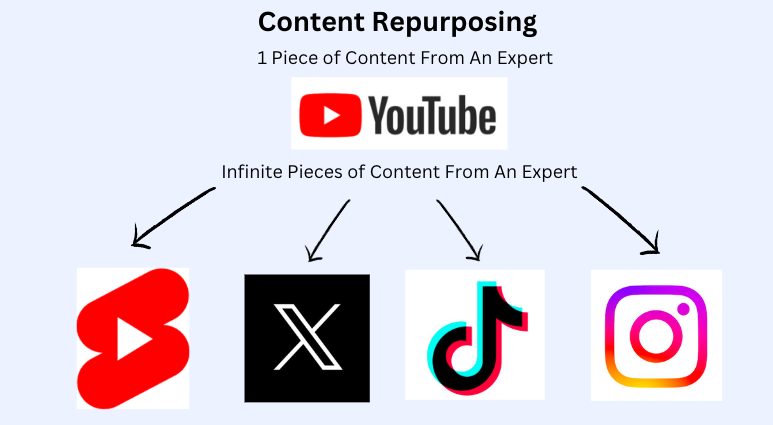
Another benefit of content repurposing is that it’s much more cost-effective than hiring freelancers to create multiple new content pieces.
Content repurposing also allows you to reach new audiences. For example, some people are only active on LinkedIn, whereas others may only be active on Instagram. Therefore, you can reach more potential customers by repurposing your content on different platforms.
How To Repurpose Content: Alex Hormozi’s Exact Framework
Here’s the step by step process Alex uses to repurpose his content.
Step 1: Validate Your Content Concept
One of the top reasons content repurposing fails is because the content concept doesn’t resonate with your audience.
Before creating a piece of content, Alex begins by testing different ideas on his Twitter account.
Then, the Tweets that earn the most engagement are repurposed into long-form content.
By testing your content ideas on low-effort platforms like Twitter, you can reduce the likelihood that your long-form content, which requires more effort and resources to produce, will fail.
In fact, publishing content on Twitter didn’t require any additional effort from Alex because he was already emailing himself his thoughts daily.
So, instead of emailing himself his thoughts, he simply began publishing them on Twitter. Today, he Tweets about five times per day.
To get started, publish your ideas and thoughts daily on a low effort platform, like Twitter or Instagram, and note which ideas earn the most traction.
What If I Don’t Have Any Followers?
The only caveat is that Alex already had several thousand followers on Twitter, so he had a substantial audience to test his content ideas.
If you don’t have any followers or only a few hundred followers, finding meaningful trends in the most popular content might not be possible.
In that case, you’ll need a different way to validate your content ideas.
One alternative method to find ideas with validated demand is to look at keywords with substantial volume. You can use a keyword research tool like Keywords Everywhere or Ahrefs to see if there’s any search volume for the keyword or content topic idea you’re considering.

You can also look at industry forums or broader public forms like Quora and Reddit to see if people are asking about the topic you’re evaluating.
For example, plenty of people are asking how to repurpose content, so I can see that there’s substantial demand for the idea of this blog post.
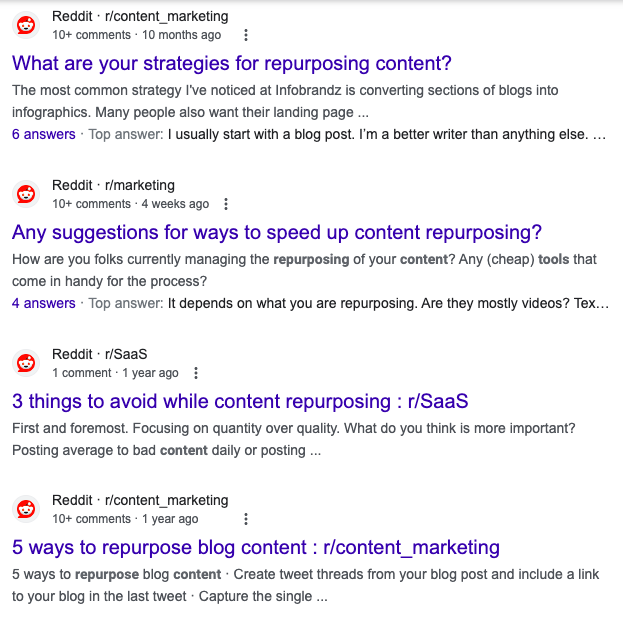
The benefit of these forums is that you can also learn what specific questions people have about the topic. For example, I can see that this person wants to know what cheap tools they can use for content repurposing, so I’ll be sure to include that later in this post:

Another great way to validate market demand is to look at commonly asked questions in Facebook groups, Slack groups, and other communities.
For example, plenty of people are asking about flooring materials in this Facebook group, so creating a blog post about the best types of flooring might perform well if I had a service in the log cabin industry.

You can also look at your competitors’ social media content and create and see what type of content performed best for them by scrolling through their social media pages and looking at the pages that earn the most website traffic.
Step 2: Create Video Content
Once you’ve identified a content idea that resonates with your audience, the next step is to turn it into video content.
Alex specifically recommends video content because you can repurpose it across audio and video-based platforms, like TikTok, Instagram, and podcasts. Your team can also extract quotes from it to repurpose as text content.
In contrast, if you start with text-based content, like a blog post, you won’t be able to publish anything on YouTube, TikTok, podcasts, or Instagram Reels.
So first, he identifies his top performing threads and turns them into long-form videos.
Here’s an example of a thread that did well, with over 188 comments:
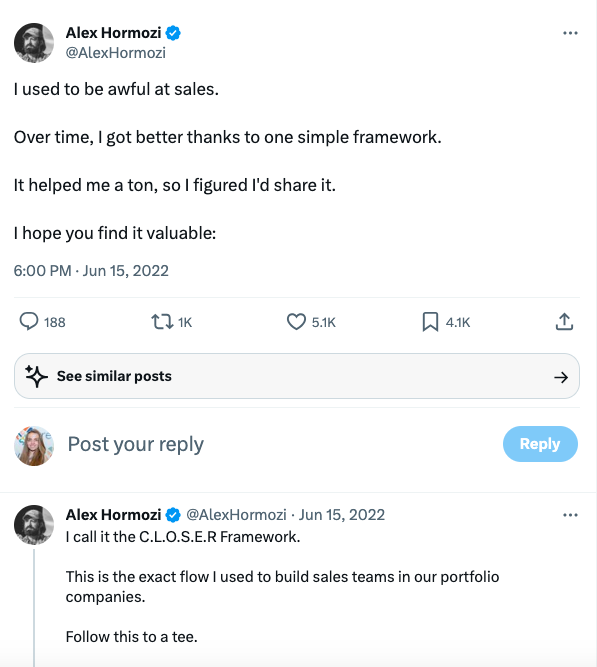
Therefore, he turned into a video with a slightly different title:

He also turns his short Tweets into short form video content. However, now that he has such a large content library, he also repurposes soundbites from interviews and keynotes into short form videos.
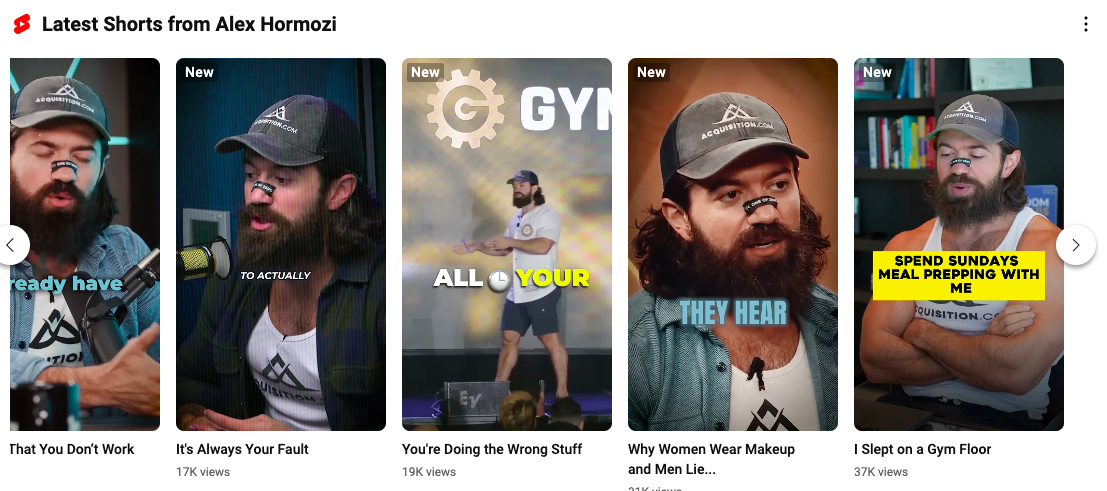
He also records the following call to actions (CTAs):
- Subscribe to another channel
- Share the content or tag a friend
- Leave a review
- Submit a question
- Download a lead magnet
- Purchase a low ticket item
- Client ask
- Grand slam offer
Then, his team simply inserts these CTAs into each piece of content during the editing process.
Alex also notes that you shouldn’t let video quality concerns hold you back from publishing video content.
In fact, many of his top performing videos weren’t recorded with fancy equipment.
Step 3: The Team Edits And Contextualizes
The next step is where the content repurposing strategy begins.
During this six month growth period, Alex’s content repurposing team consisted of five people:
- Twitter Editor
- YouTube Editor
- LinkedIn Editor
- Podcast Editor
- IG Reels/TikTok Editor
The total cost of this team and the entire content production was $40,000.
After Alex records the video, these team members jump in and begin repurposing that content across all of those platforms.
They also inject CTAs into each piece of content. For the long-form videos and podcasts, they injected three CTAs in the content: at the beginning, middle, and end.
However, if you don’t have the resources to hire a team to repurpose content for you, you can still do this either for free with very little effort on your part, or you can hire a virtual assistant on Upwork to do it for you.
Here’s an example of a content repurposing agency/freelancer on Upwork:
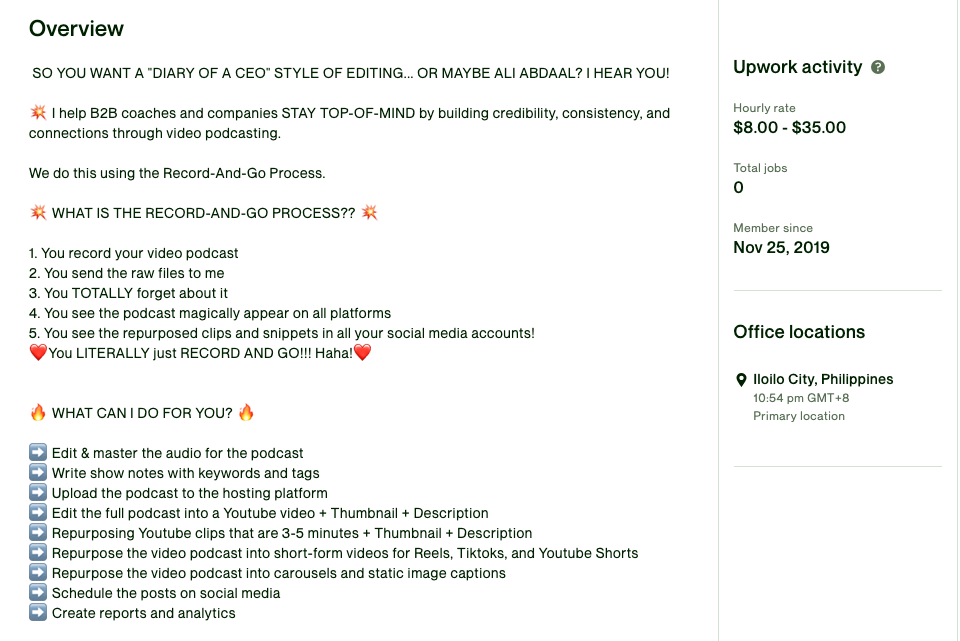
You could also use a service like Repurpose House to do this for you.
As you hire people to repurpose your content, be sure that the agency or freelancer understands that they must format each piece of content for the platform they’re publishing on.
Therefore, give them guidelines like:
- Include text subtitles for all video content (and specify the type of font you want)
- Use relevant hashtags
- Follow formatting best practices for written content on Twitter and LinkedIn
You can also give them brand assets, like logos and colors, as well as voice and style guidelines.
Step 4: Distribute And Monitor
The last step in the process is publishing the content. The graphic below shows what Alex’s distribution strategy looked like before implementing this strategy (publishing seven times per week) to what it looks like now (publishing 80 times per week):

Here’s an example of a piece of content that Alex recorded and his team repurposed. It began as a Twitter thread:
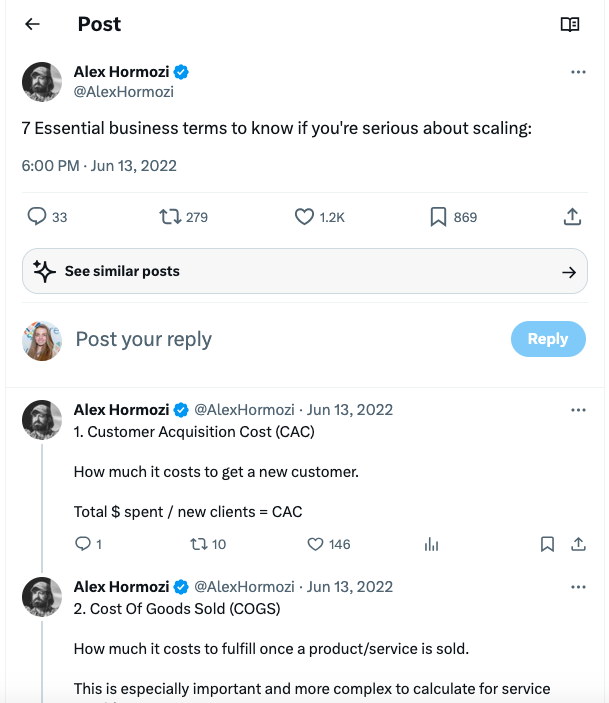
As it performed well, the team decided to record a video about it:

You can also see that he repurposed this short Tweet:

It performed well, so they also reposted it on LinkedIn with another picture:

Then, he later repurposed it on Instagram:
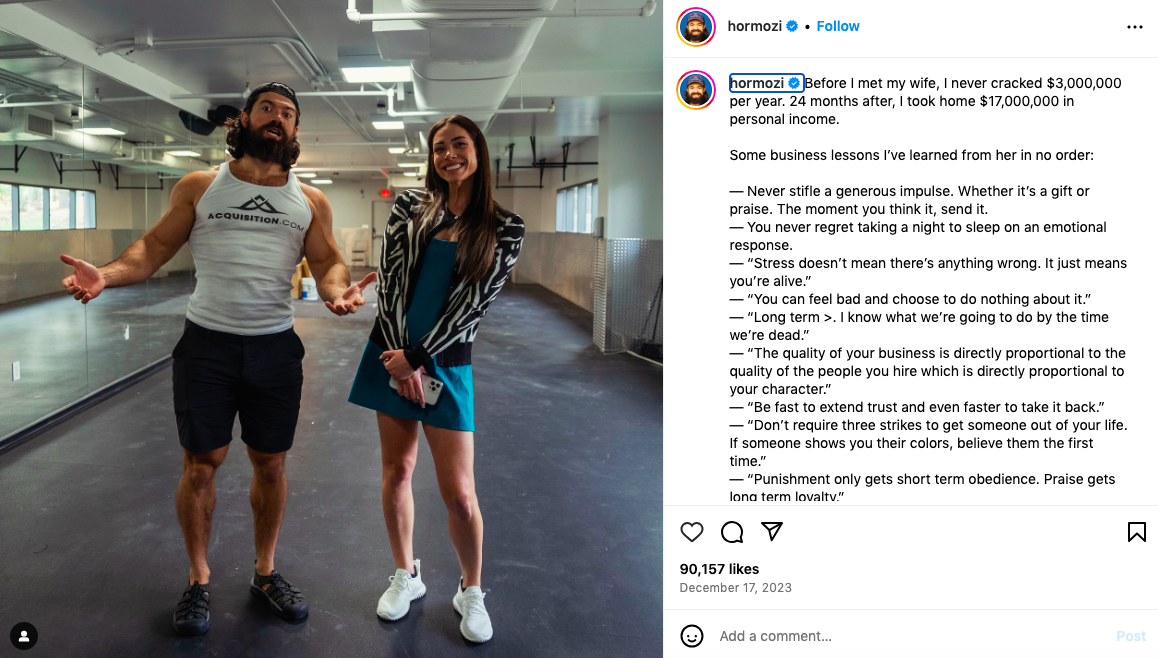
Each time, he only changed the picture.
To streamline the process, you can use a content calendar/publishing platform like Buffer to schedule the content so it always goes out on time.
If you’re working with freelancers who aren’t particularly skilled in content creation, you should have an approval process to ensure they’re extracting the best clips and quotes from your long form content.
If you use a tool like Buffer, the team can give them “Approval Required” access so that you can still review all of the content before it’s published.
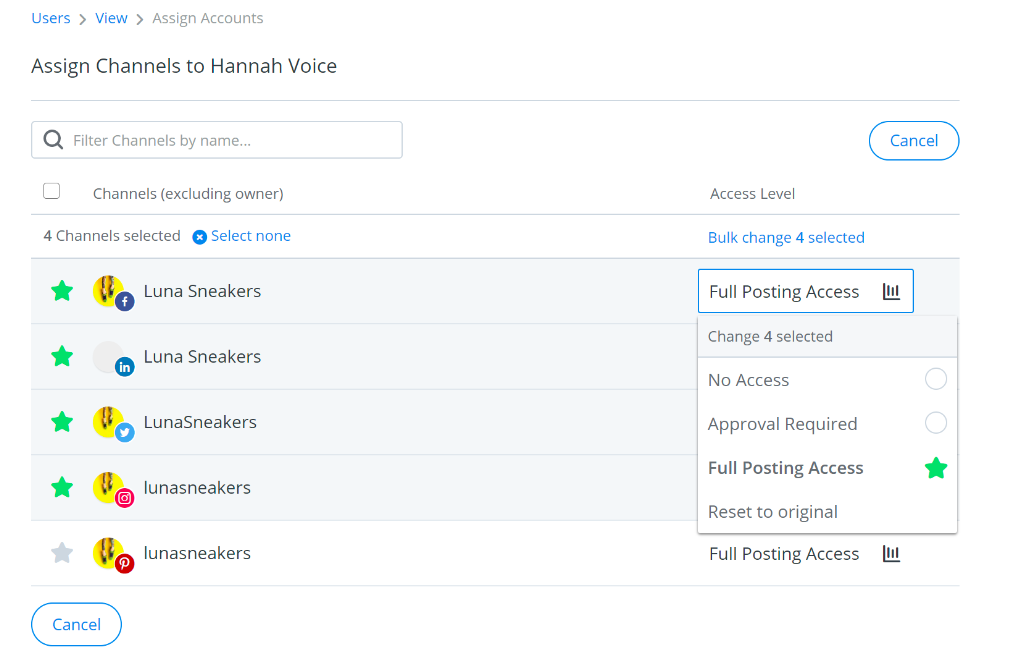
If you’re not happy with the quality of the content, you may have to either select the soundbites yourself that you want them to repurpose or you may have to hire a more expensive content repurposer.
Content Repurposing Checklist
While that’s a full overview of Alex’s content repurposing strategy, here’s a quick checklist to create your own content repurposing workflow.
Step 1: Validate Your Content Idea
- Publish at least one social media post daily and analyze which one gains the most traction to turn into long form content.
- Look at forums and online communities/groups to see which ones did the best.
Step 2: Create Long Form Content (Ideally Video)
- Take the top performing idea from your social media post and write a video script for it.
- Record the video. Note that you don’t need fancy or expensive equipment for this step.
Step 3: Hire A Video Editor And Social Media Strategist
- Hire a video editor on a platform like Upwork or YT Jobs.
- Have the editor also repurpose the long form videos into clips and format them to the various short form video platforms (TikTok, Instagram, etc.).
- Hire a social media strategist to post across text-based platforms.
Step 4: Distribute Your Content
- Use a scheduling tool like Buffer to schedule your content to publish
Finally, even though this is how Alex repurposes his content, there are plenty of other content formats you can use to repurpose your content.
For example, you could repurpose your content as a guest post, infographic, or white paper. You can also use other social media platforms, like Pinterest and even Slideshare.
Finally, you don’t need to create new content to start repurposing content.
Look at Google Analytics and identify your top performing evergreen content. Then, repurpose them.
You can also update your old blog posts and then republish them.
If you’re trying to help your content get even more reach, you can also use other content promotion strategies, like partnering with influencers to share it and even running paid ads to it.
Start Repurposing Your Content Today
Rather than creating new content, look at your existing content and think about how you can reuse it to help it achieve more reach.
However, your results will depend directly on the quality of the initial piece of content you create. We have plenty of blog posts here at Copyblogger that can help you create high quality content, but if you want more one on one help, you can join the Copyblogger Academy.
Inside, you’ll have access to courses on content marketing, personal branding, copywriting, and other marketing strategies. You’ll can also ask the Copyblogger team specific questions, connect with other content creators, and get feedback on your work.
You can try the Copyblogger Academy risk free today to see if it’s a good fit for you.















